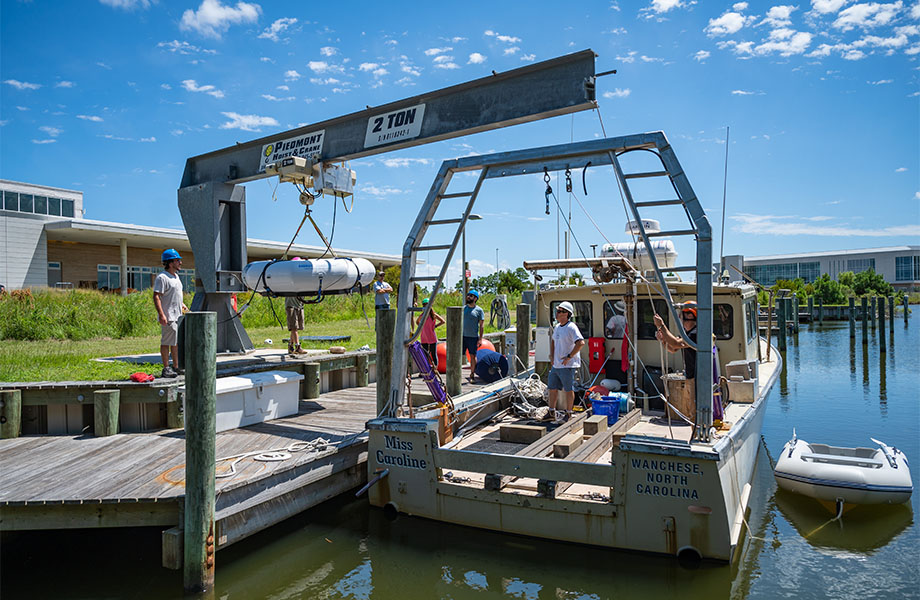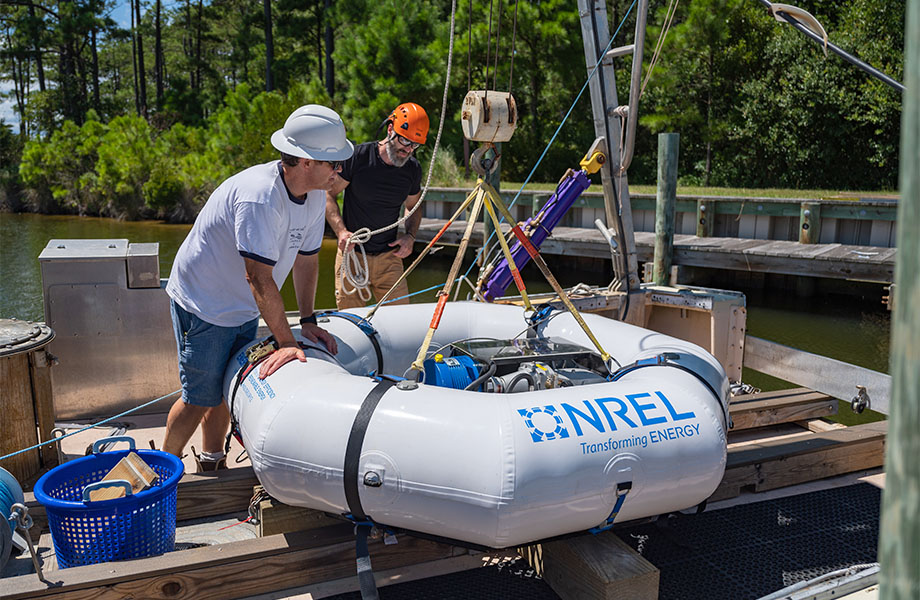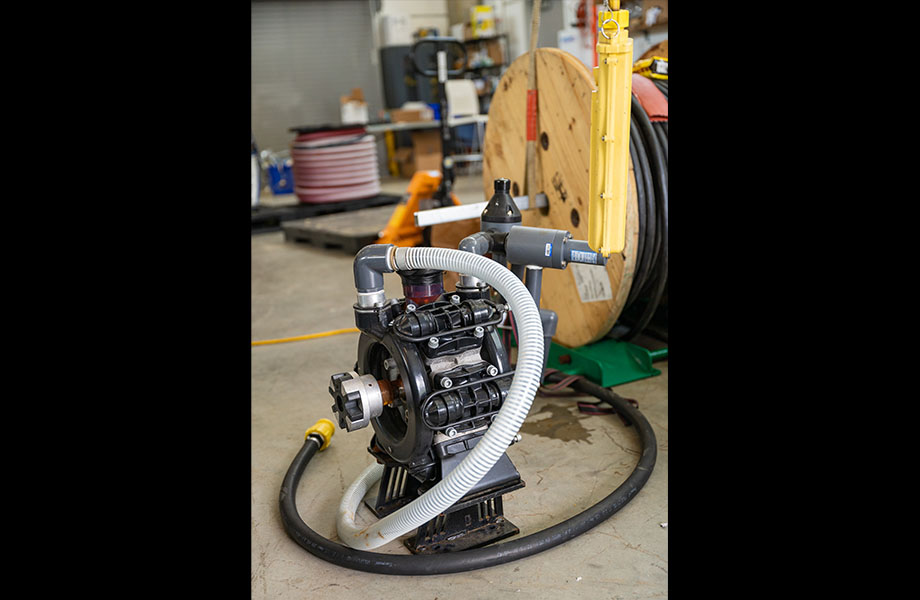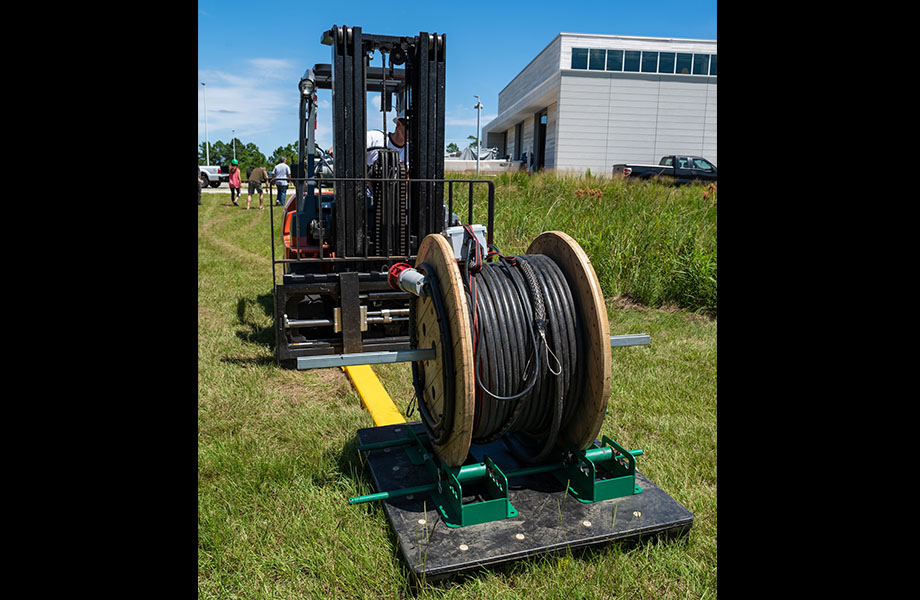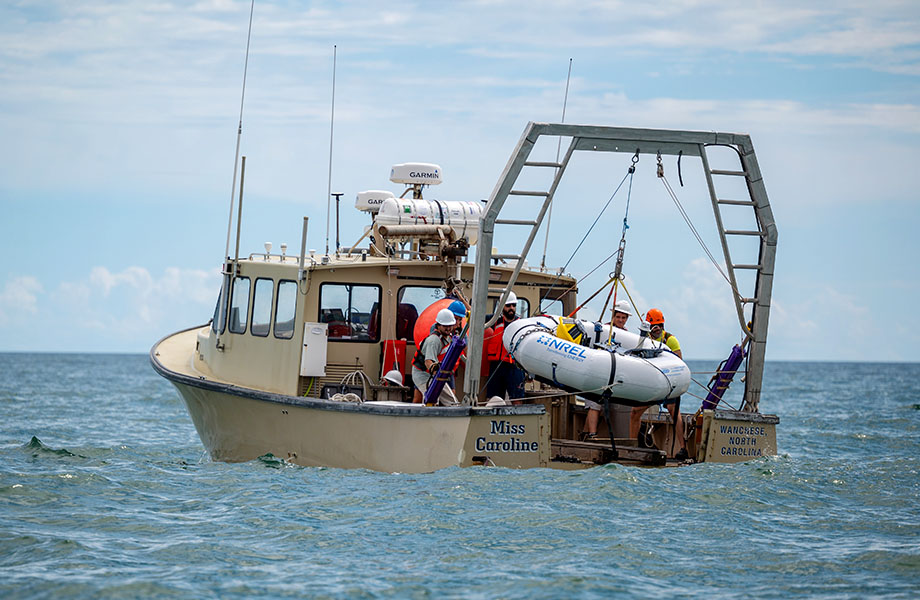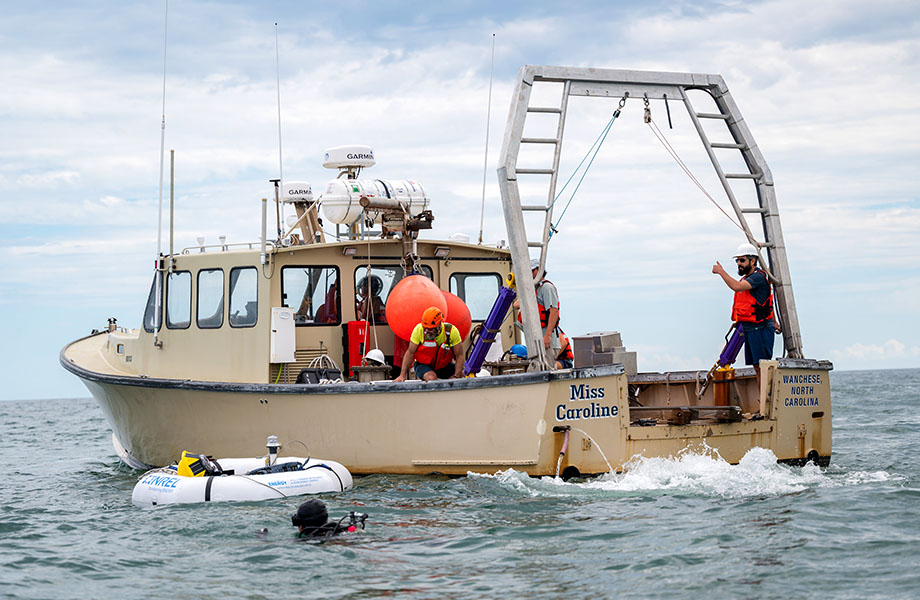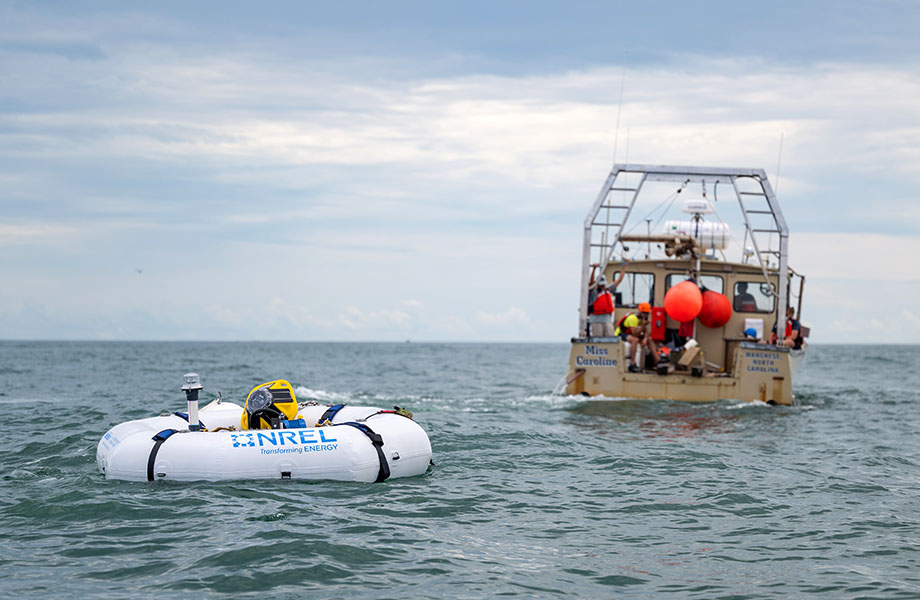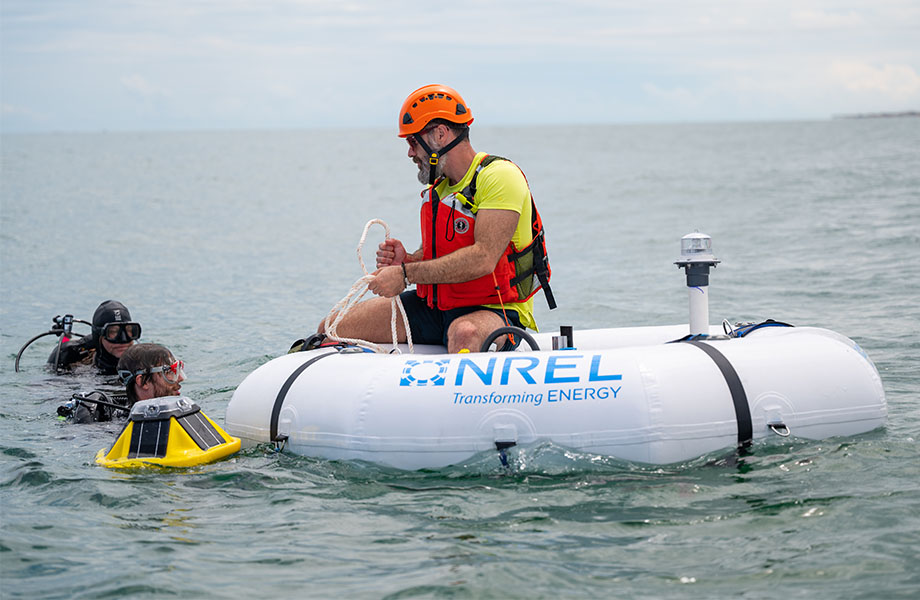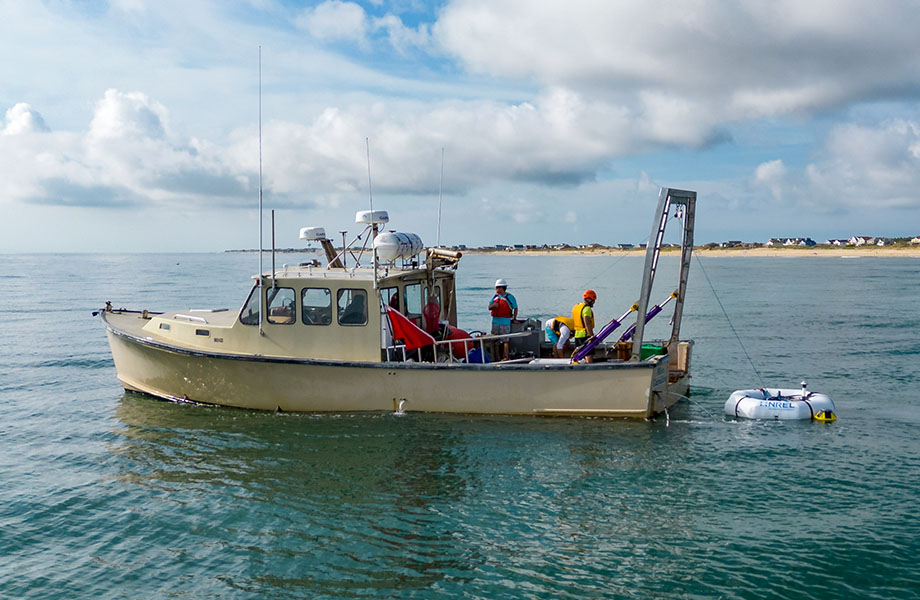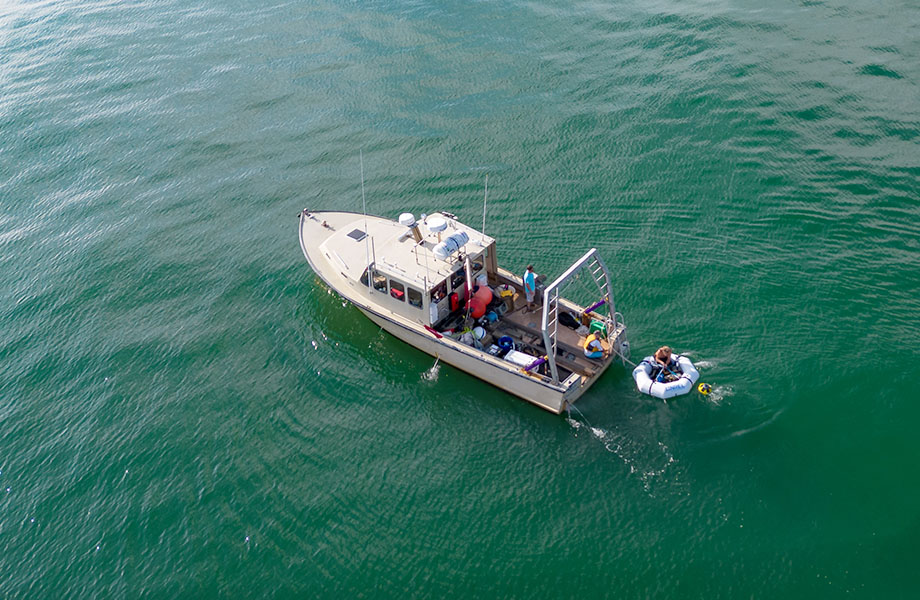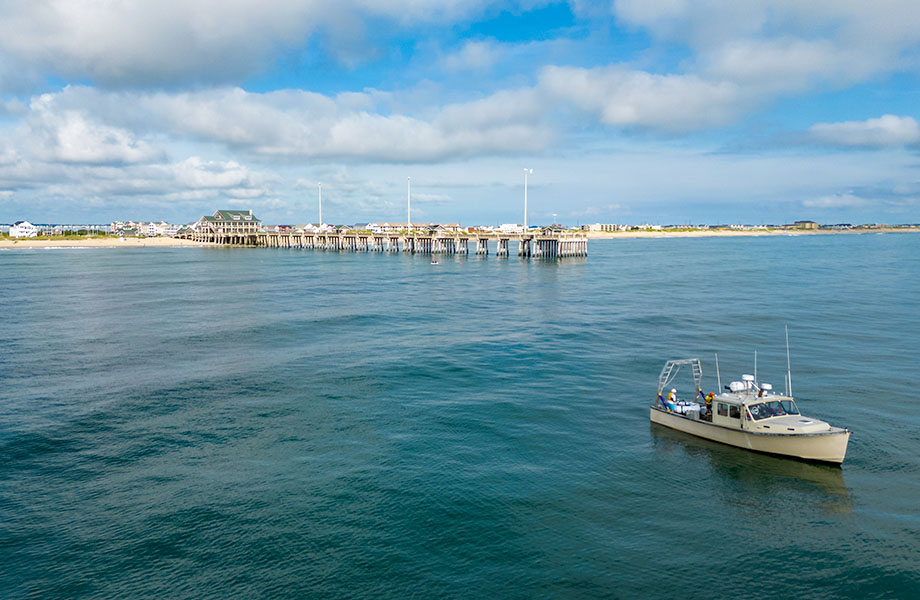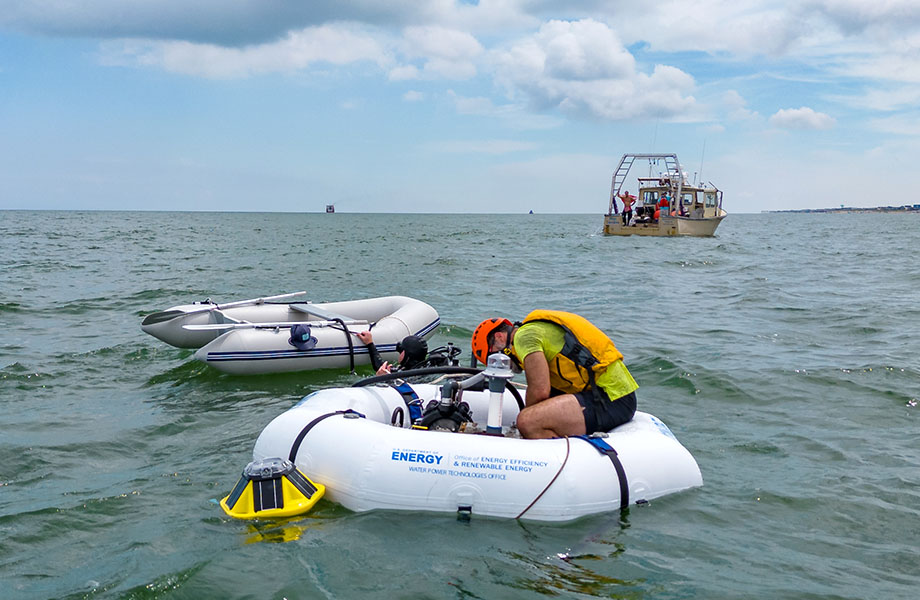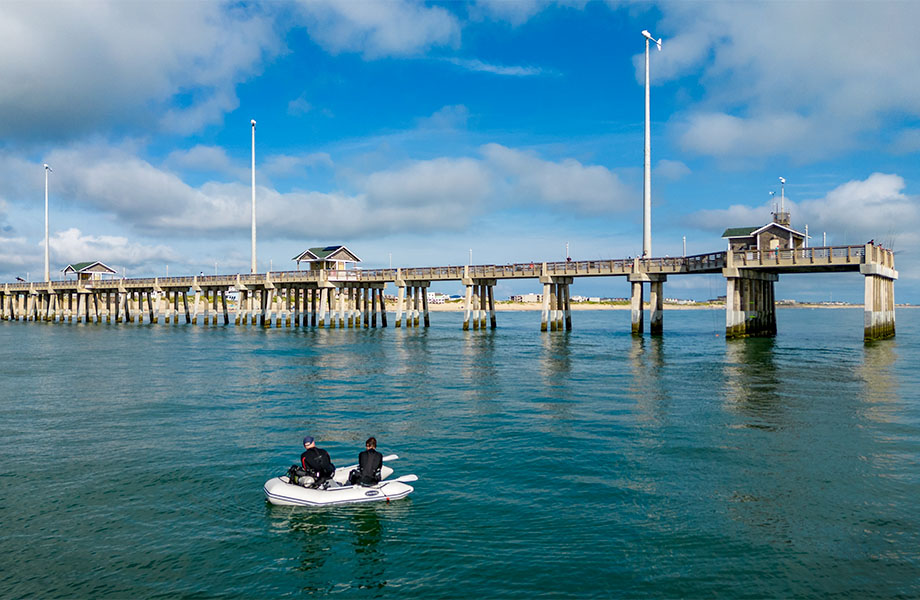A HERO's Journey:
NREL's Wave-Powered Desalination Device Returns to the Outer Banks
Feb. 16, 2023 | By Brittany Enos | Contact media relations
North Carolina's Outer Banks come alive in the summertime. The sunshine and shorelines invite people from near and far—surfers, vacationers, and even engineers.
In August 2022, National Renewable Energy Laboratory (NREL) researchers journeyed to the Outer Banks for more than the fresh seafood and lively piers. They were on a mission to deploy NREL's first wave-powered desalination device for a second in-water test.
"In the second deployment, we focused on capturing data and ended up learning a lot about what we didn't know," said Scott Jenne, NREL's marine energy systems engineering and techno-economic lead and principal investigator for the U.S. Department of Energy's Waves to Water Prize. "Going into this deployment, we knew that our electrical system was not optimized due to the limited capabilities of off-the-shelf components, but we weren't able to fully quantify those limitations until we took it to the ocean."
NREL researchers began designing the hydraulic and electric reverse osmosis (HERO) wave energy converter (WEC) in summer 2020 and finished building it in January 2022. The hexagonal device measures about 6 feet in diameter (or roughly the size of a round dining table), weighs approximately 750 pounds, and mimics the design parameters that guided Waves to Water Prize competitors. The NREL research team followed those guidelines to become more familiar with the competitors' prototype designs and installation requirements.
The HERO WEC can desalinate seawater using a hydraulic or electric power conversion system. The hydraulic system relies on the simple up-and-down motion of waves to create pressure and pump ocean water through a hose and into a land-based reverse osmosis system. Alternatively, the electric system uses the motion of the waves to engage an onboard rotary generator to create electricity. The electricity then travels through a subsea cable to power an onshore pump that draws water from the ocean and pushes it through the same reverse osmosis desalination system.
The team previously visited North Carolina's Outer Banks with the HERO WEC in February 2022 to practice deploying wave-powered desalination devices for the first time. That exercise gave insight to both NREL and the Coastal Studies Institute, which hosted the Waves to Water Prize DRINK Stage finale two months later, in April 2022, so they could ensure a safe and fair competition.
This animation shows how the winch engages the onboard gearbox as the HERO WEC moves up and down in the waves. Animation by NREL
After the first HERO WEC deployment and the Waves to Water DRINK Finale, the NREL team added data collection systems to the device so they could more accurately measure its performance. These data collection systems also help them better understand how dynamic ocean forces impact devices like the HERO WEC, ultimately advancing critical research on small-scale WECs.
Before sending the device back out to sea, researchers installed two different sensor packages on the HERO WEC to measure pull force (or tension in the line), the device's location and the position of the winch, which is a critical component. The winch allows the HERO WEC to harness the full energy of a wave by translating the up-and-down motion of the WEC into rotational motion. This rotational motion engages the onboard gearbox, which ultimately powers the energy conversion system.
The HERO WEC, NREL's first wave-powered desalination system, rides the waves off Jennette's Pier in Nags Head, North Carolina, enabling researchers to gather real-world data that advance critical research on small-scale WECs.
For the second in-ocean test, the NREL and the Coastal Studies Institute crew loaded the HERO WEC onto a work vessel, boated out to the waters surrounding Jennette's Pier, and anchored it to the seabed. The prototype spent nearly 10 days in the water. During that time, the team gathered more data from the two sensor packages they installed, which helped them analyze the device's interaction with various wave conditions and ocean forces (like buoyancy). They also had the opportunity to test the electric system in the ocean for the first time—which successfully produced desalinated water.
"It's quite a lengthy process for the divers to get the device in the water and installed, and doing that successfully and safely was very impressive to witness," said Aryana Nakhai, an engineer for NREL's water power portfolio who helped design and build the electric system. "But once that electrical cable was deployed and connected to the system, I started seeing live voltage and that was super exciting. But just because we saw voltage didn't necessarily mean we were producing water. So once the system actually started desalinating the water for the first time, it was a surreal moment."
A key part of the HERO WEC's electrical system is the onshore power electronics enclosure—a box of components that regulates the voltage coming in from the waves. Compared to other variable renewable energy sources (like solar), wave energy is extremely scattered. Each wave holds its own amount of high or low energy, so even though the generator is sending power to the power electronics box on land, the voltage of that power is never constant.
The enclosure stabilizes those irregular voltages and currents by converting the alternating current (AC) into direct current (DC) so that a DC charge controller can regulate the WEC's incoming power. DC current can also be stored in batteries. When the battery bank is sufficiently charged, the stored energy is then converted into a constant 120-volt, 60-hertz signal (just like the power coming from a typical household wall outlet) to power the water pump, which sends seawater through the desalination system.
"In a real-world environment, there won't always be waves or waves big enough to produce useful power," Nakhai said. "So, the configuration and control within the enclosure were designed to maintain power no matter the wave conditions."
After five days of testing the electrical system in open water, the team swapped it for the hydraulic energy conversion system, testing that for the remaining five days.
The water remained fairly calm, and wave conditions were not strong enough to power the hydraulic system. However, the team still demonstrated that it is possible to perform a major drivetrain swap at sea.
This was the first time the team exchanged the systems in open water, providing one of the first data points for in-water operations—in particular, device maintenance—of marine energy technologies. By unhooking the HERO WEC, pulling it onboard the boat, and swapping the component, the team showed what can be done at sea—and what types of maintenance activities are not ideal to perform on the water.
"I think the biggest success for us is that we built a device that survived," Jenne said. "When the wave conditions were rough, the HERO WEC stayed attached and did exactly what it was supposed to do without any failures. We did have to tune the system, but that's expected for a system that had never been in actual waves before. Other than that, everything went very smoothly, and the device performed how we had anticipated."
Now that the research team has initial data on the HERO WEC, they will make that WEC data publicly available and work toward solutions for communities that need access to both fresh water and reliable, clean energy.
"A big challenge in wave energy is access to validated designs and proven solutions. And as a national lab, we can make this information more accessible," said Ben McGilton, an engineer for NREL's water power portfolio who helped design and build the electric power take-off system. "The really exciting thing about the HERO WEC project is that we're making everything open source, meaning that any team or developer will be able to hopefully learn from the effort itself, particularly in terms of the challenges we overcame, approach to both the hydraulic and electrical system, and designing a system that can meet highly fluctuating extreme conditions."
"I think this information is going to have a huge impact because access to water is going to become more and more challenging," McGilton said. "The sooner we can get these types of systems out there, the sooner we can improve access to both clean water and clean energy."
Now, the team will focus on gaps identified during the second deployment, like comparing different charge controllers and quantifying how efficiently they perform. The team also plans to improve other components that make up the HERO WEC's electrical system before deploying it again next summer. As the team works to further complete NREL's research on wave-powered desalination, they will continue to publicly publish new findings, data points, and design changes or upgrades. Iterating on the HERO WEC design and sharing the evolving research will be critical to advancing marine renewable energy technologies—making them more reliable, resilient, and affordable.
Learn more about NREL's research in marine energy, the first HERO WEC deployment, the HERO WEC device, and open-source data. And subscribe to NREL's water power newsletter.
Share
Last Updated May 1, 2025

